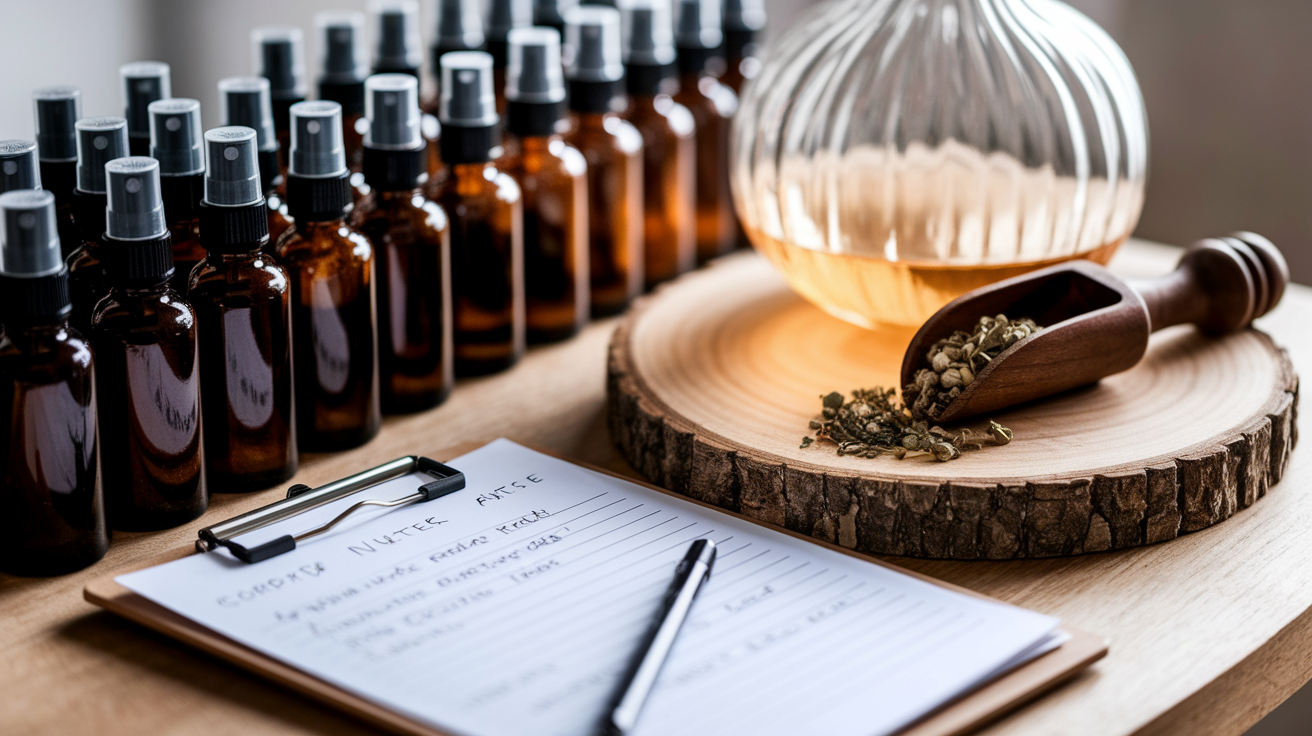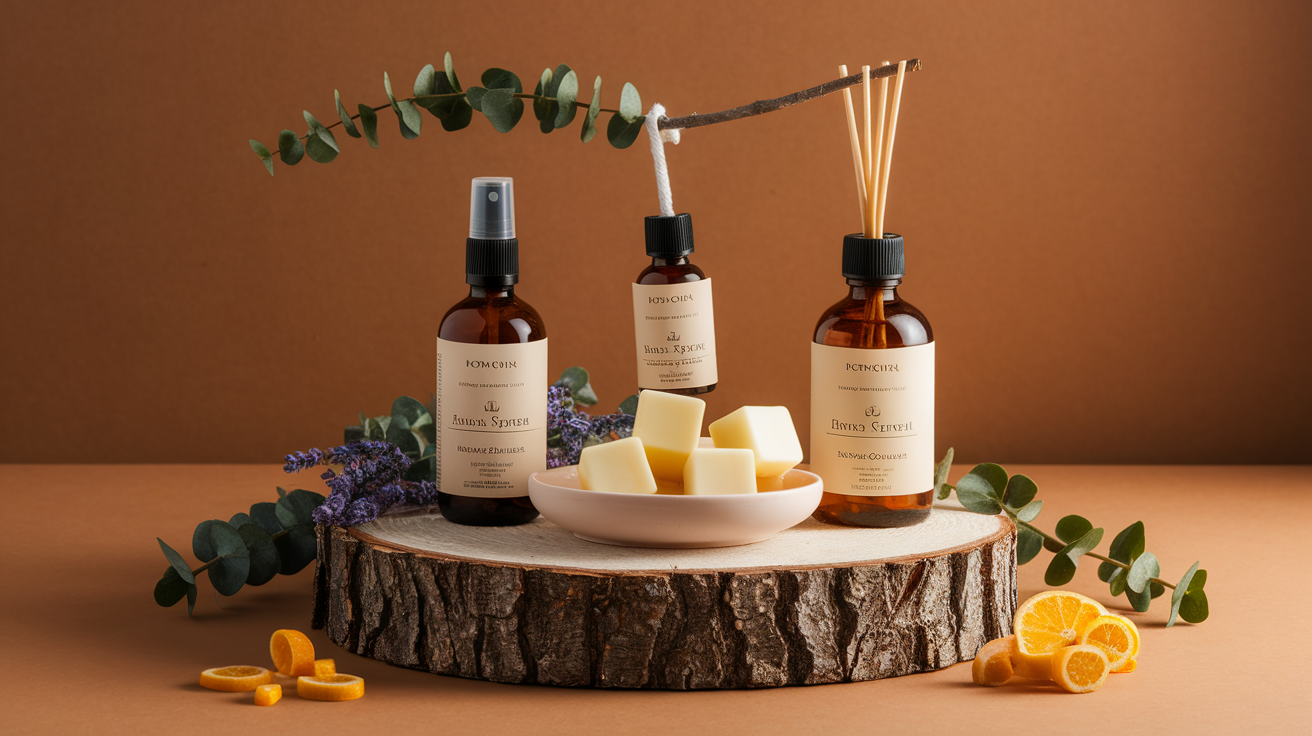Room sprays are simple to make and highly profitable to sell. You can create your own room spray business with basic ingredients like distilled water, witch hazel, essential oils, and some attractive bottles and labels. I’ve spent the last decade working with essential oils and have seen room sprays become one of the hottest home fragrance products on the market. If you’ve been looking for a creative side hustle with low startup costs, this might be perfect for you! Many of my students make just a few scents in their kitchen and grow into successful small businesses. This guide walks you through everything you need to know to create room sprays customers will love and build a business that can grow with you.
Choosing Scents and Ingredients
Starting with the right scents is crucial for your room spray business. As an essential oil specialist, I’ve found that fragrance selection can make or break your product line.
Most successful room spray businesses focus on:
- Popular scent categories (relaxing lavender, energizing citrus, cozy vanilla)
- Seasonal offerings (pine and cinnamon for winter, floral for spring)
- Unique signature blends that set your brand apart
Many of my students succeed using high-quality essential oils rather than synthetic fragrances. While slightly more expensive upfront, essential oils give your products natural credibility that many customers seek. Juniper fir fragrance makes an excellent holiday option, while lavender, eucalyptus, and citrus oils perform well year-round.
Stick with food-grade or cosmetic-grade components for your base ingredients. Distilled water forms the foundation, while witch hazel or high-proof alcohol helps the oils disperse and adds preservative properties.
Popular Essential Oil Combinations for Room Sprays
| Spray Name | Essential Oil Blend | Target Customer |
|---|---|---|
| Sleep Easy | Lavender + Chamomile + Bergamot | Busy professionals seeking relaxation |
| Clean & Fresh | Lemon + Eucalyptus + Tea Tree | Homeowners wanting a clean scent |
| Stress Less | Frankincense + Clary Sage + Orange | Office workers and students |
| Holiday Joy | Pine + Cinnamon + Orange | Seasonal shoppers |
| Energy Boost | Peppermint + Rosemary + Grapefruit | Morning routines and workspaces |
Quality Considerations for Ingredients
When selecting ingredients, I always recommend:
- Organic or wildcrafted essential oils when possible
- Distilled water (never tap water)
- Natural preservatives for product longevity
- Witch hazel as a natural base with skin-safe properties
The quality of your ingredients directly affects customer satisfaction and repeat purchases. I’ve seen businesses fail by cutting corners here, so invest in the best ingredients your price point can support.
Sourcing Supplies Efficiently
Building relationships with wholesale suppliers can significantly reduce your costs. Many of my students start with small quantities from retail stores but quickly graduate to wholesale purchasing as their business grows.
Formulating the Room Spray

Creating a consistently excellent room spray requires precision and attention to detail. I’ve refined my formulation process over years of testing.
The basic room spray formula I recommend to my students is:
- 80-90% distilled water
- 5-10% witch hazel or high-proof alcohol
- 2-5% essential oil blend
- Optional: Polysorbate 20 (1-2%) to help oils blend with water
CandleScience recommends a specific ratio of 142g base + 35g fragrance + 531g water for their pre-made EcoBase product, which eliminates the need for separate emulsifiers and preservatives.
Step-by-Step Production Process
- Sanitize all equipment and bottles
- Measure ingredients by weight for consistency
- Mix water and witch hazel/alcohol in a glass measuring cup
- Add polysorbate 20 if using
- Add essential oils or fragrance oils
- Stir gently but thoroughly
- Pour into spray bottles using a funnel
- Label products with batch number and date
For larger batches, using a pouring jug and funnel setup helps minimize spills and ensures consistent filling.
Testing for Quality and Safety
Every batch should undergo testing before selling:
- Spray pattern test (should produce fine mist)
- Scent throw test (in different size rooms)
- Stability test (check for separation after 24-48 hours)
- Shelf-life test (monitor sample over time)
Many of my students create small test batches before scaling up to full production runs. This saves money and helps perfect formulations.
Troubleshooting Common Issues
If your spray isn’t performing well, check these common issues:
- Fragrance separation: Add or increase polysorbate 20
- Weak scent: Adjust essential oil percentage (up to 5% maximum)
- Spotting on surfaces: Reduce oil content or increase emulsifier
- Preservative failures: Consider a broad-spectrum preservative like Optiphen Plus
Packaging and Labeling

Your packaging is often the first thing customers notice. I’ve seen room spray businesses transform their sales simply by upgrading their presentation.
Glass bottles generally look more premium than plastic ones, but they increase shipping weight and breakage risk. For local sales, amber or cobalt glass bottles with fine mist sprayers make a wonderful impression. For online shipping, high-quality PET plastic bottles might be more practical.
Bottle Selection and Sourcing
Common room spray bottle options include:
- 2oz amber glass bottles (good starter size)
- 4oz clear glass bottles (popular retail size)
- 1oz sample/travel size bottles
- Custom-shaped bottles for premium lines
When buying bottles, look for reliable sprayer mechanisms that produce a fine mist. Nothing frustrates customers more than a sprayer that drips or produces uneven spray patterns.
Creating Professional Labels
Your label needs to:
- Comply with all regulatory requirements
- Clearly list ingredients
- Include your brand name and logo
- Feature batch number and production date
- Provide usage instructions
- Show contact information
Business registration and licensing requirements vary by location, so make sure your labels meet local standards.
Packaging Presentation and Branding
Beyond the bottle and label, consider:
- Branded gift boxes for premium positioning
- Tissue paper wrapping for gift-ready presentation
- Hang tags with scent descriptions
- Thank you cards for customer orders
Some of my most successful students include small extras like sample vials of new scents with each order, encouraging repeat business.
Pricing and Marketing

Setting the right price for your room sprays balances profitability with market expectations. I recommend a detailed cost analysis for each product.
Calculating Costs and Setting Prices
For each bottle of room spray, calculate:
- Raw material costs (ingredients)
- Packaging costs (bottle, sprayer, label)
- Labor costs (your time has value!)
- Overhead expenses (website fees, market booth rental)
- Shipping costs (if applicable)
Most successful room spray businesses use a 3-5x markup from raw costs. For example, if a bottle costs $3 to make, retail pricing might be $9-15 depending on your target market and brand positioning.
Finding Your Target Market
Room spray customers generally fall into several categories:
- Home décor enthusiasts seeking coordinated fragrances
- Natural living advocates wanting chemical-free alternatives
- Gift buyers looking for unique handmade items
- Businesses seeking signature scents (boutiques, spas, offices)
Identify which segment aligns best with your product and focus your marketing efforts accordingly.
Sales Channels for Room Sprays
Successful room spray businesses typically sell through multiple channels:
- Etsy shops for handmade positioning
- Shopify or standalone websites for brand control
- Local craft markets and gift fairs
- Wholesale to boutiques and gift shops
- Pop-up shops during holiday seasons
Many of my students start with Etsy and local markets before expanding to their own websites and wholesale accounts.
Marketing Strategies That Work
Effective marketing for room spray businesses includes:
- Beautiful product photography (crucial for online sales)
- Scent descriptions that evoke emotional responses
- Social media content showing your creation process
- Customer testimonials and reviews
- Seasonal promotions and limited edition scents
Email marketing remains one of the most effective tools for room spray businesses, with scent-of-the-month clubs and subscription options creating reliable income.
Scaling and Expansion

As your room spray business grows, systematic scaling becomes important. I’ve guided many students through this growth phase.
Increasing Production Capacity
To scale production efficiently:
- Create production schedules with batch planning
- Invest in larger mixing equipment
- Develop a filing system for formula records
- Set up dedicated production space
- Consider hiring help for bottling and labeling
This tutorial demonstrates practical mixing and bottling techniques that can be adapted for larger scale production.
Expanding Your Product Line
Successful room spray businesses often expand into:
- Linen sprays (same formula, different marketing)
- Car diffusers and travel sizes
- Custom scents for events (weddings, corporate gifts)
- Complementary products (candles, diffusers, wax melts)
When expanding your line, maintain scent consistency across product types to build recognizable signature fragrances.
Legal Considerations for Growth
As you grow, additional regulations may apply:
- Business insurance becomes essential
- Cosmetic regulations may apply if making skin-safe claims
- Manufacturing facilities may need inspection
- Employee regulations if hiring staff
Business registration and licensing requirements should be thoroughly researched before significant expansion.
Maintaining Quality at Scale
Quality control becomes increasingly important as production volume grows:
- Create a quality checklist for each batch
- Implement batch coding for tracking
- Establish regular supplier quality reviews
- Set up customer feedback mechanisms
- Schedule regular formula reviews and improvements
My most successful students maintain the handcrafted quality feel even as they scale to significant production volumes.
Conclusion
Making room sprays to sell combines creativity with solid business potential. With minimal startup costs and equipment, you can create products customers will love while building a profitable business. Throughout this guide, I’ve shared the essential steps: selecting quality ingredients, perfecting your formulations, creating attractive packaging, pricing for profit, marketing effectively, and planning for growth.
Start small with a few signature scents and test your market. Pay attention to customer feedback and be willing to adjust your offerings. Remember that consistency and quality will build your reputation and lead to repeat business. The room spray market continues to grow as more people seek natural alternatives to commercial air fresheners.
Take the first step today by ordering supplies for a test batch. Your room spray business begins with a single bottle!













